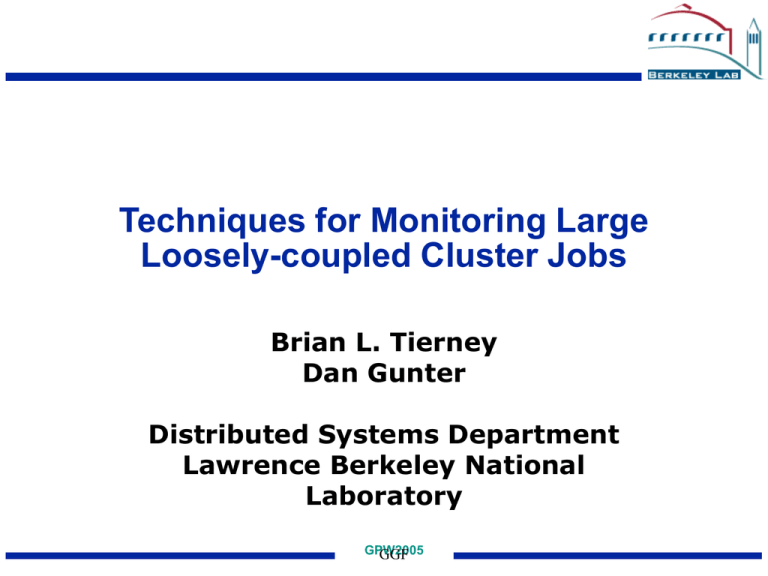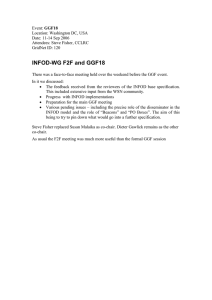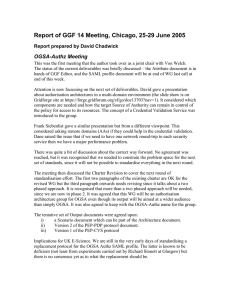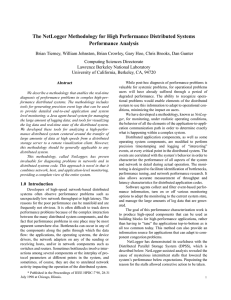Techniques for Monitoring Large Loosely-coupled Cluster Jobs Brian L. Tierney Dan Gunter
advertisement

Techniques for Monitoring Large
Loosely-coupled Cluster Jobs
Brian L. Tierney
Dan Gunter
Distributed Systems Department
Lawrence Berkeley National
Laboratory
GPW2005
GGF
Tightly Coupled vs.
Loosely Coupled
• Cluster applications can be classified as follows:
– Tightly Coupled: jobs have a large amount of communication
between nodes, usually using specialized interfaces such as the
Message Passing Interface (MPI)
– Loosely Coupled: jobs have occasional synchronization points, but
are largely independent
– Uncoupled: jobs have no communication or synchronization points
• An important class of parallel processing jobs on clusters today are
workflow-based applications that process large amounts of data in
parallel
– e.g.: searching for supernovae or Higgs particles
– In this context we define workflow as the processing steps required
to analyze a unit of data
GPW2005
GGF
Uncoupled / Loosely Coupled Jobs
• Often this type of computing is I/O or database bound, not CPU bound.
• Performance analysis requires system-wide analysis of competition for
resources such as disk arrays and database tables
– This is very different from traditional parallel processing analysis of
CPU usage and explicitly synchronized communications
• There are a number of performance analysis tools which focus on
tightly coupled applications.
– we are focused on uncoupled and loosely coupled applications
GPW2005
GGF
Tools for Tightly Coupled Jobs
• Traditional parallel computing performance analysis tools focus on
CPU usage, communication, and memory access patterns. e.g.:
– TAU (http://www.csi.uoregon.edu/nacse/tau/)
– Paraver (http://www.cepba.upc.edu/paraver/overview.htm)
– FPMPI (http://www-unix.mcs.anl.gov/fpmpi/WWW/)
– Intel Trace Collector
(http://www.intel.com/software/products/cluster/tcollector/)
• A number of other projects that started out as mainly for tightly coupled
applications
– Then were extended or adapted to work for loosely coupled
systems as well
• These include:
– SvPablo (http://www.renci.unc.edu/Project/SVPablo/SvPabloOverview.htm)
– Paradyn (http://www.paradyn.org/)
– Prophesy (http://prophesy.cs.tamu.edu/)
GPW2005
GGF
Sample Loosely Coupled Job
• An example of an uncoupled cluster application is the
Nearby Supernova Factory (SNfactory) project at LBL
– Mission: to find and analyze nearby “Type Ia”
supernovae
– http://snfactory.lbl.gov/
• SNfactory jobs are submitted to PDSF cluster at NERSC,
and typically run on 64-128 nodes
• SNfactory jobs produce about one monitoring event per
second on each node
– total of roughly up to 1,100,000 events per day
• Roughly 1% of jobs were failing for unknown reasons
– SNfactory group came to us for help
GPW2005
GGF
Sample Loosely Coupled Job
GPW2005
GGF
Sample Distribution of Job completion Time
Q: What is the cause of the very long tail?
GPW2005
GGF
NetLogger Toolkit
• We have developed the NetLogger Toolkit (short for
Networked Application Logger), which includes:
– tools to make it easy for distributed applications to log
interesting events at every critical point
– tools for host and network monitoring
• The approach combines network, host, and applicationlevel monitoring to provide a complete view of the entire
system.
• This has proven invaluable for:
– isolating and correcting performance bottlenecks
– debugging distributed applications
GPW2005
GGF
NetLogger Components
• NetLogger Toolkit contains the following components:
– NetLogger message format
– NetLogger client library (C, Java, Python, Perl)
– NetLogger visualization tools
– NetLogger host/network monitoring tools
• Additional critical component for distributed applications:
– NTP (Network Time Protocol) or GPS host clock is
required to synchronize the clocks of all systems
GPW2005
GGF
NetLogger Methodology
•
•
NetLogger is both a methodology for analyzing distributed systems,
and a set of tools to help implement the methodology.
– You can use the NetLogger methodology without using any of the
LBNL provided tools.
The NetLogger methodology consists of the following:
1. All components must be instrumented to produce monitoring
These components include application software, middleware,
operating system, and networks. The more components that are
instrumented the better.
2. All monitoring events must use a common format and common set
of attributes and a globally synchronized timestamp
3. Log all of the following events: Entering and exiting any program or
software component, and begin/end of all IO (disk and network)
4. Collect all log data in a central location
5. Use event correlation and visualization tools to analyze the
monitoring event logs
GPW2005
GGF
NetLogger Analysis: Key
Concepts
•
•
•
NetLogger visualization tools are based on time correlated and object
correlated events.
– precision timestamps (default = microsecond)
If applications specify an “object ID” for related events, this allows the
NetLogger visualization tools to generate an object “lifeline”
In order to associate a group of events into a “lifeline”, you must assign an
“object ID” to each NetLogger event
– Sample Event ID: file name, block ID, frame ID, Grid Job ID, etc.
GPW2005
GGF
Sample NetLogger
Instrumentation
log = netlogger.LogOutputStream(“my.log”)
done = 0
while not done:
log.write("EVENT.START",{"TEST.SIZE”:size})
# perform the task to be monitored
done = do_something(data,size)
log.write("EVENT.END”,{})
• Sample Event:
t
s
s
l
s
l
DATE=20000330112320.957943
HOST=gridhost.lbl.gov
PROG=gridApp
LVL=Info
NL.EVNT=WriteData
SEND.SZ=49332
GPW2005
GGF
SNfactory Lifelines
GPW2005
GGF
Scaling Issues
• Running a large number of workflows on a cluster will generate far too
much monitoring data to be able to use the standard NetLogger lifeline
visualization techniques to spot problems.
– For even a small set of nodes, these plots can be very dense
GPW2005
GGF
Anomaly Detection
• To address this problem, we designed and developed a
new NetLogger automatic anomaly detection tool, called
nlfindmissing
• The basic idea is to identify lifelines that are missing
events.
– Users define the events that make up an important
linear sequence within the workflow, as a lifeline.
• The tool then outputs the incomplete lifelines on a data file
or stream.
GPW2005
GGF
Lifeline Timeouts
• Issue: given an open-ended dataset that is too large to fit in memory,
how to determine when to give up waiting for a lifeline to complete?
• Our solution:
– approximate the density function of the lifeline latencies by
maintaining a histogram with a relatively large (e.g. 1000) bins
– the timeout becomes a user-selected section of the tail of that
histogram, e.g. the 99th percentile
• This works well, runs in a fixed memory footprint, is computationally
cheap, and does not rely on any assumptions about the distribution of
the data
– additional parameters, such as a minimum and maximum timeout
value, and how many lifelines to use as a ``baseline'' for dynamic
calculations, make the method more robust to messy real-world
data
GPW2005
GGF
Anomalies Only
GPW2005
GGF
Anomalies Plus Context
GPW2005
GGF
NetLogger Cluster Deployment
GPW2005
GGF
Monitoring Data Management Issues
• A challenge for application instrumentation on large
clusters is sifting through the volume of data that even a
modest amount of instrumentation can generate.
• For example,
– a 24 hour application run produces 50MB of application
and host monitoring data per node
– while a 32-node cluster might be almost manageable
(50 MB x 32 nodes = 1.6 GB)
– when scaled to a 512-node cluster the amount of data
starts to become quite unwieldy (50 x 512 = 25.6 GB).
GPW2005
GGF
Data Collection
GPW2005
GGF
nldemux
• The nldemux tool is then used to group monitoring data
into manageable pieces.
– the ganglia data is placed in its own directory, and data
from each node is written to a separate file;
– the entire directory is rolled over once per day.
– the workflow data are placed in files named for the
observation date at the telescope,
• this information is carried in each event record
– data is removed after 3 weeks
GPW2005
GGF
NetLogger and Grid Job IDs
GPW2005
GGF
Grid Workflow Identifiers (GIDs)
• Globally unique key needed to identify a workflow
• Propagated down and across workflow components
– This is the hard part!
– Options:
• modify app. interfaces
• add SOAP header
Acronyms:
RFT = Reliable File Transfer service
GridFTP = Grid File Transfer Protocol
PBS = Portable Batch System
HPSS = High Performance Storage System
SRM = Storage Resource Manager
GPW2005
GGF
Without GIDs
GPW2005
GGF
With GIDs
GPW2005
GGF
For More Information
• http://dsd.lbl.gov/NetLogger/
– Source code (open source) and publications available
GPW2005
GGF





